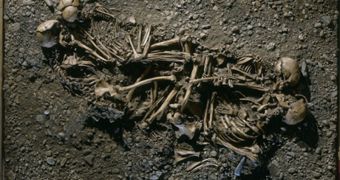As indicated in a previous article, the remains of an ancient family have recently been unearthed in Germany, close to the city of Eulau. This has also been demonstrated to be the earliest ever genetic evidence of a nuclear family discovered. The impressive batch of Stone Age graves also provided clues to the fact that the members of the family were defending against an attack before they died and were buried. The 13 graves were dated to 4,600 years ago, and the results of the study demonstrated that the individuals were all interred at the same time.
The buried persons varied in age, from very young children to adults over 30 years old, both males and females. They were facing each other even in their graves, and their hands were intertwined. The pieces of evidence of the assault stand out at a closer examination: the back bone of a woman contained a stuck stone arrowhead, the skull of another showed multiple fractures, while the hands and arms of the other members were marked by "defense injuries".
"By establishing the genetic links between the two adults and two children buried together in one grave, we have established the presence of the classic nuclear family in a prehistoric context in Central Europe - to our knowledge the oldest authentic molecular genetic evidence so far," explained University of Adelaide's lead study author, Wolfgang Haak, quoted by Discovery. "Their unity in death suggests a unity in life. However, this does not establish the elemental family to be a universal model or the most ancient institution of human communities."
Using the strontium isotope (contained by various food types and stored in teeth through the years) analysis technique, the scientists were also able to deduce how the group was socially organized. Dr. Alistair Pike, Head of the University of Bristol's Archeology Department, who co-directed the project, shared that "The strontium analysis showed that the females spent their childhood in a different region from the males and children. This is an indication of exogamy (marrying out) and patrilocality (the females moving to the location of the males). Such traditions would have been important to avoid inbreeding and to forge kinship networks with other communities".
The term “nuclear family” refers to a family of any size that typically consists of two parents (a father and a mother) and their siblings, unlike an extended family, which also comprises other (extra-nuclear) family members (uncles, grandparents, nephews, cousins, etc.) living together with the parents and their children.
The images were provided courtesy of Landesamt fur Denkmalpflege und Archaologie Sachsen-Anhalt (State Office for Heritage Management and Archeology Saxony-Anhalt), and photographer Juraj Liptak. The graves are currently on permanent display at the Landesmuseum Sachsen-Anhalt in Germany.

 14 DAY TRIAL //
14 DAY TRIAL //